扁形动物门
扁形动物门(學名:;語源: platy 扁平 + helminth- 蟲[2])是动物界的一个门,是一类簡單的無環節两侧对称动物,屬於無脊椎動物,有三胚层,无体腔,無呼吸及循環系統,有口,但无肛门,所以必須保持身體扁平,以使氧氣及養料能夠透過滲透來吸收。消化腔只有一個開口,同時用於進食及排泄;所以食物在其體內無法有效處理。
| 扁形动物门 化石时期:270–0 Ma[1] | |
|---|---|
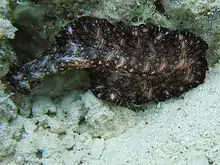 | |
| 貝德福德扁形蟲(Pseudobiceros bedfordi) | |
| 科学分类 | |
| 界: | 动物界 Animalia |
| 演化支: | 肾管动物 Nephrozoa |
| 演化支: | 原口动物 Protostomia |
| –未分级–: | 螺旋動物 Spiralia |
| 总门: | 扁蟲動物總門 Platyzoa |
| 门: | 扁形动物门 Platyhelminthes Claus, 1887 |
| 綱 | |
|
傳統分類: 支序分類
| |
| 異名 | |
| |
已记录的扁形动物约有29500种[3]。生活於淡水、海水等潮溼處,體前端有兩個可感光的色素點。體表部分或全部分布有纖毛。
傳統的醫學文獻會將扁形動物劃分為非寄生的渦蟲綱(例如:真渦蟲科的物種)和三個會寄生的物種的綱:絛蟲綱、吸蟲綱及單殖綱。然而,由於渦蟲綱已證實並非單系群,這種劃分方式在動物學來看已經過時。
非寄生的扁蟲都是捕食者,棲息於水中或遮蔭的陸上潮濕環境,例如落葉堆等。寄生種如絛蟲和吸蟲的生命週期比較複雜:牠們的成熟階段會以寄生蟲的形式居住在魚類或陸上脊椎動物的消化系統裡;而中間宿主階段會尋找可被感染的中間宿主。吸虫的卵从最终宿主体内排出,而成年绦虫会产生大量雌雄同体的节片,在成熟后会分离,排出宿主,再释放卵。与其他寄生的类群不同,单殖纲是水生生物的体外寄生虫,其幼虫在附着于合适宿主之後,再变态为成虫。
因为扁形动物没有体腔,它们曾被认为是最原始的两侧对称动物。但是,在1980年代中期以来的研究发现原来被分类为扁形动物的一个群体──无腔动物门,离最初的两侧对称动物较任何其他现代类群更近。除去无腔动物后的扁形动物门是一个单系群,即是有一个共同祖先及其所有后裔组成的。扁形动物门属于冠轮动物,是较复杂的两侧对称动物的三个进化支之一。近年來的分析顯示出已重新定義、不再包含無腔動物門的扁形動物門,是由兩個單系群,即小鎖狀目和被杆體綱所組成的;而絛蟲綱、吸蟲綱和單殖綱則組成了被杆體綱下的一個分支──新皮類底下的單系群,至於傳統的渦蟲綱物種範圍則涵蓋了除新皮類外的所有扁形動物。因此,傳統上認定的渦蟲綱現在被認為是並系群,因為其不包含從傳統渦蟲綱分支出去的寄生性物種之類群。
超过一半已知的扁形动物属于寄生虫, 而且某些物種會對人類以及牲畜造成很大的傷害。血吸蟲病是由吸蟲綱裂體屬的物種所造成的,是所有由寄生蟲造成的人類疾病中第二致命的,僅次於瘧疾。囊蟲腦病變是當豬肉絛蟲的幼體(囊尾幼蟲)侵入中樞神經系統時產生, 是後天獲得之癲癇的主因之一。這些寄生性物種在開發中國家的威脅來自於生食與未完全煮熟之食物受到歡迎,以及從高風險地區的進口。在低度開發的國家中,人們可能無法負擔用以煮熟食物之燃料的費用,再加上設計不良之供水系統以及灌溉工程,使得不良的公共衛生及農業衛生提高被感染之風險。
兩種扁形動物在菲律賓、印尼、夏威夷、新幾內亞和關島被用來控制威脅原生種蝸牛生存的外來種非洲大蝸牛之族群大小,並收到良好成效。但是,最近發現這些扁形動物可能自身就會威脅原生種蝸牛的生存。在西北歐地區,以蚯蚓為食的紐西蘭扁蟲(Arthurdendyus triangulatus)的散播引起各方擔憂。
描述
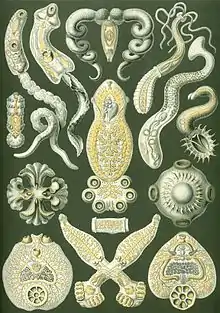
分辨性特徵
扁形動物皆為 兩側對稱动物:牠們的左半側與右半側互為鏡像;這亦表示了這些動物可以分辨出其頂部與底部 、以及其頭部及尾部。就像其他的两侧对称动物,牠們的细胞可分成三個胚層,即:內胚層、中胚層及外胚層[4],而刺胞動物及栉水母等輻射對稱動物則只有兩個胚層[5]。Beyond that, they are "defined more by what they do not have than by any particular series of specializations."[6]。 不同於其他两侧对称动物,扁形动物並沒有體腔, 所以被稱為無體腔動物。牠們也沒有特化的循环系统及呼吸系統器官,而這些都是為扁形動物分類時的解剖特徵[4][7]。牠們的身體是柔軟且沒有分節的[8]。
| 特徵 | 而刺胞動物及栉水母等[5] | 扁形动物[4][7] | 較「高級」的两侧对称动物[9] |
|---|---|---|---|
| 兩側對稱 | 否 | 是 | |
| 胚層數 | 兩層,中間夾有啫喱狀夾層 | 三層 | |
| 有可分辨的脑部 | 無 | 有 | |
| 特化的消化系统 | 無 | 有 | |
| 特化的排洩系統 | 無 | 有 | |
| 體腔內有內臟 | 無 | 有 | |
| 特化的循环系统及呼吸系統器官 | 無 | 有 | |
Features common to all subgroups
The lack of circulatory and respiratory organs limits platyhelminths to sizes and shapes that enable oxygen to reach and carbon dioxide to leave all parts of their bodies by simple diffusion. Hence, many are microscopic and the large species have flat ribbon-like or leaf-like shapes. The guts of large species have many branches, allowing nutrients to diffuse to all parts of the body.[6] Respiration through the whole surface of the body makes them vulnerable to fluid loss, and restricts them to environments where dehydration is unlikely: sea and freshwater, moist terrestrial environments such as leaf litter or between grains of soil, and as parasites within other animals.[4]
The space between the skin and gut is filled with mesenchyme, a connective tissue made of cells and reinforced by collagen fibers that act as a type of skeleton, providing attachment points for muscles. The mesenchyme contains all the internal organs and allows the passage of oxygen, nutrients and waste products. It consists of two main types of cell: fixed cells, some of which have fluid-filled vacuoles; and stem cells, which can transform into any other type of cell, and are used in regenerating tissues after injury or asexual reproduction.[4]
Most platyhelminths have no anus and regurgitate undigested material through the mouth. However, some long species have an anus and some with complex, branched guts have more than one anus, since excretion only through the mouth would be difficult for them.[7] The gut is lined with a single layer of endodermal cells that absorb and digest food. Some species break up and soften food first by secreting enzymes in the gut or pharynx (throat).[4]
All animals need to keep the concentration of dissolved substances in their body fluids at a fairly constant level. Internal parasites and free-living marine animals live in environments with high concentrations of dissolved material, and generally let their tissues have the same level of concentration as the environment, while freshwater animals need to prevent their body fluids from becoming too dilute. Despite this difference in environments, most platyhelminths use the same system to control the concentration of their body fluids. Flame cells, so called because the beating of their flagella looks like a flickering candle flame, extract from the mesenchyme water that contains wastes and some reusable material, and drive it into networks of tube cells which are lined with flagella and microvilli. The tube cells' flagella drive the water towards exits called nephridiopores, while their microvilli reabsorb reusable materials and as much water as is needed to keep the body fluids at the right concentration. These combinations of flame cells and tube cells are called protonephridia.[4][9]
In all platyhelminths, the nervous system is concentrated at the head end. This is least marked in the acoels, which have nerve nets rather like those of cnidarians and ctenophores, but densest around the head. Other platyhelminths have rings of ganglia in the head and main nerve trunks running along their bodies.[4][7]
主要亞群
早期分類將扁形動物分為四組,即:渦蟲綱、吸蟲綱、單殖綱及絛蟲綱。這個分類長久以來都被認為是一種人工強行分類,所以Ehlers (1985)[10]提出一個比較符合系統發生學觀點的分類,將渦蟲綱分為12個目,然後再將吸蟲類、單殖類和絛蟲類等寄生蟲組合成一個新的Neodermata目。可是這個分類仍然主要只為科學文獻採用[4],所以以下我們仍然以傳統分類去介紹扁形動物的分類。
渦蟲綱
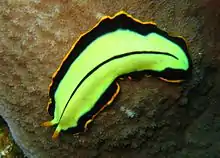
渦蟲綱包括有物種4500種[7]均能自由遷徙,長度從1 mm(0.039英寸)到600 mm(24英寸)不等。大多數為掠食者或者是食腐動物。多居住在陰暗潮濕的地方,如落葉底下。然而,部分物種會與其他動物(例如:甲殼類動物)共生、甚或是寄生。Free-living turbellarians are mostly black, brown or gray, but some larger ones are brightly colored.[4] The Acoela and Nemertodermatida were traditionally regarded as turbellarians,[7][11] but are now regarded as members of a separate phylum, the Acoelomorpha,[12][13] or as two separate phyla.[14] Xenoturbella, a genus of very simple animals,[15] has also been reclassified as a separate phylum.[16]
Some turbellarians have a simple pharynx lined with cilia and generally feed by using cilia to sweep food particles and small prey into their mouths, which are usually in the middle of their undersides. Most other turbellarians have a pharynx that is eversible (can be extended by being turned inside-out), and the mouths of different species can be anywhere along the underside.[4] The freshwater species Microstomum caudatum can open its mouth almost as wide as its body is long, to swallow prey about as large as itself.[7]
Most turbellarians have pigment-cup ocelli ("little eyes"), one pair in most species, but two or even three pairs in some. A few large species have many eyes in clusters over the brain, mounted on tentacles, or spaced uniformly around the edge of the body. The ocelli can only distinguish the direction from which light is coming and enable the animals to avoid it. A few groups have statocysts, fluid-filled chambers containing a small, solid particle or, in a few groups, two. These statocysts are thought to be balance and acceleration sensors, as that is the function they perform in cnidarian medusae and in ctenophores. However, turbellarian statocysts have no sensory cilia, and how they sense the movements and positions of the solid particles is unknown. On the other hand, most have ciliated touch-sensor cells scattered over their bodies, especially on tentacles and around the edges. Specialized cells in pits or grooves on the head are probably smell sensors.[7]
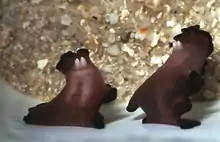
Planarians, a subgroup of seriates, are famous for their ability to regenerate if divided by cuts across their bodies. Experiments show that, in fragments that do not already have a head, a new head grows most quickly on those closest to the original head. This suggests the growth of a head is controlled by a chemical whose concentration diminishes from head to tail. Many turbellarians clone themselves by transverse or longitudinal division, and others, especially acoels, reproduce by budding.[7]
The vast majority of turbellarians are hermaphrodites (have both female and male reproductive cells), and fertilize eggs internally by copulation.[7] Some of the larger aquatic species mate by penis fencing, a duel in which each tries to impregnate the other, and the loser adopts the female role of developing the eggs.[17] In most species, "miniature adults" emerge when the eggs hatch, but a few large species produce plankton-like larvae.[7]
吸蟲綱
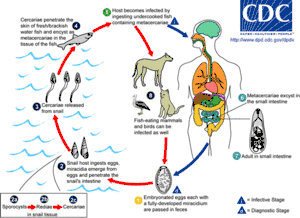
吸蟲綱的學名源自希臘語的,意思就是一個孔洞,refers to the cavities in their holdfasts[4] which resemble suckers and anchor them within their hosts.[8] 。 The skin of all species is a syncitium, a layer of cells that shares a single external membrane. Trematodes are divided into two groups, Digenea and Aspidogastrea (also known as Aspodibothrea).[7]
複殖亞綱
These are often called flukes, as most have flat rhomboid shapes like that of a flounder (Old English flóc). There are about 11,000 species, more than all other platyhelminthes combined, and second only to roundworms among parasites on metazoans.[7] Adults usually have two holdfasts, a ring around the mouth and a larger sucker midway along what would be the underside in a free-living flatworm.[4] Although the name "Digeneans" means "two generations", most have very complex life cycles with up to seven stages, depending on what combinations of environments the early stages encounter – most importantly whether the eggs are deposited on land or in water. The intermediate stages transfer the parasites from one host to another. The definitive host in which adults develop is a land vertebrate, the earliest host of juvenile stages is usually a snail that may live on land or in water, and in many cases a fish or arthropod is the second host.[7] For example, the adjoining illustration shows the life cycle of the intestinal fluke metagonimus, which hatches in the intestine of a snail; moves to a fish, where it penetrates the body and encysts in the flesh; then moves to the small intestine of a land animal that eats the fish raw; and then generates eggs that are excreted and ingested by snails, thereby completing the cycle. Schistosomes, which cause the devastating tropical disease bilharzia, belong to this group.[18]
Adults range between 0.2 mm(0.0079英寸) and 6 mm(0.24英寸) in length. Individual adult digeneans are of a single sex, and in some species, slender females live in enclosed grooves that run along the bodies of the males, and partially emerge to lay eggs. In all species, the adults have complex reproductive systems and can produce between 10,000 and 100,000 times as many eggs as a free-living flatworm. In addition, the intermediate stages that live in snails reproduce asexually.[7]
Adults of different species infest different parts of the definitive host, for example the intestine, lungs, large blood vessels,[4] and liver.[7] The adults use a relatively large, muscular pharynx to ingest cells, cell fragments, mucus, body fluids or blood. In both the adults and the stages that live in snails, the external syncytium absorbs dissolved nutrients from the host. Adult digeneans can live without oxygen for long periods.[7]
Aspidogastrea
Members of this small group have either a single divided sucker or a row of suckers that cover the underside.[7] They infest the guts of bony or cartilaginous fish and of turtles, and the body cavities of marine and freshwater bivalves and gastropods.[4] Their eggs produce ciliated swimming larvae, and the life cycle has one or two hosts.[7]
Cercomeromorpha
These parasites attach themselves to their hosts by means of disks that bear crescent-shaped hooks. They are divided into Monogenea and Cestoda.[7]
單殖綱
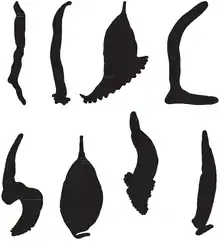
單殖綱,舊作單殖目,目前包括約1100個物種,絕大多數都是外部寄生蟲,需要特定物種作為中間宿主。體型細小,約2~3 cm長。這些中間宿主以魚類最為常見,但有時也可以是兩棲類或水生爬蟲類動物。少數屬於內部寄生蟲。單殖綱的成蟲在其後端有大型的附著器官,haptors (Greek ἅπτειν, haptein, means "catch"), which have Sucker (parasitic worm anatomy), clamp (zoology), and hooks. They often have flattened bodies. In some species, the 咽 secretes enzymes to digest the host's skin, allowing the parasite to feed on blood and cellular debris. Others graze externally on mucus and flakes of the hosts' skins. 「單殖綱」這名稱源由於這些寄生蟲的生命週期只有一個非蚴階段(Nonlarval stage)[7]。
絛蟲綱
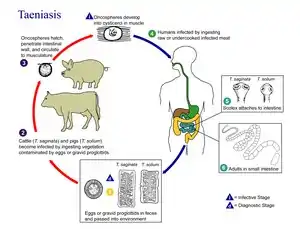
絛蟲有扁瘦但非常長的身體。其學名 “cestode”的字根源於拉丁語的,意思就是「帶子」。這3400個絛蟲的物種的成蟲都是內部寄生蟲。牠們沒有口部和腸臟, and the syncitial skin absorbs nutrients – mainly carbohydrates and amino acids – from the host, and also disguises it chemically to avoid attacks by the host's immune system.[7] Shortage of carbohydrates in the host's diet stunts the growth of the parasites and kills some. Their metabolisms generally use simple but inefficient chemical processes, and they compensate by consuming large amounts of food relative to their size.[4]
In the majority of species, known as eucestodes ("true tapeworms"), the neck produces a chain of segments called proglottids by a process known as strobilation. Hence, the most mature proglottids are furthest from the scolex. Adults of Taenia saginata, which infests humans, can form proglottid chains over 20(66英尺) long, although 4(13英尺) is more typical. Each proglottid has both male and female reproductive organs. If the host's gut contains two or more adults of the same cestode species, they generally fertilize each other, but proglottids of the same worm can fertilize each other and even fertilize themselves. When the eggs are fully developed, the proglottids separate and are excreted by the host. The eucestode life cycle is less complex than that of digeneans, but varies depending on the species. For example:
- Adults of Diphyllobothrium infest fish, and the juveniles use copepod crustaceans as intermediate hosts. Excreted proglottids release their eggs into the water, and the eggs hatch into ciliated, swimming larvae. If a larva is swallowed by a copepod, it sheds the cilia and the skin becomes a syncitium and the larva makes its way into the copepod's hemocoel (internal cavity that is the main part of the circulatory system) and attached itself with three small hooks. If the copepod is eaten by a fish, the larva metamorphoses into a small, unsegmented tapeworm, drills through to the gut and becomes an adult.[7]
- Various species of Taenia infest the guts of humans, cats and dogs. The juveniles use herbivores – for example pigs, cattle and rabbits – as intermediate hosts. Excreted proglottids release eggs that stick to grass leaves and hatch after being swallowed by a herbivore. The larva makes its way to the herbivore's muscles and metamorphoses into an oval worm about 10(0.39英寸) long, with a scolex that is kept inside. When the definitive host eats infested and raw or undercooked meat from an intermediate host, the worm's scolex pops out and attaches itself to the gut, and the adult tapeworm develops.[7]
A members of the smaller group known as Cestodaria have no scolex, do not produce proglottids, and have body shapes like those of diageneans. Cestodarians parasitize fish and turtles.[4]
Classification and evolutionary relationships
| Bilateria |
| ||||||||||||||||||||||||||||||||||||||||||||||||||||||||||||
Note: Bold indicates members of traditional "Platyhelminthes".
| Platyhelminthes |
| |||||||||||||||||||||||||||||||||||||||||||||||||||||||||
The oldest confidently identified parasitic flatworm fossils are cestode eggs found in a Permian shark coprolite, but helminth hooks still attached to Devonian acanthodians and placoderms might also represent parasitic flatworms with simple life cycles.[23] The oldest known free-living platyhelminth specimen is a fossil preserved in Eocene age Baltic amber and placed in the monotypic species Micropalaeosoma balticus,[24] while the oldest subfossil specimens are schistosome eggs discovered in ancient Egyptian mummies.[8] The Platyhelminthes have very few synapomorphies, distinguishing features that all Platyhelminthes and no other animals have. This makes it difficult to work out both their relationships with other groups of animals and the relationships between different groups that are described as members of the Platyhelminthes.[25]
The "traditional" view before the 1990s was that Platyhelminthes formed the sister group to all the other bilaterians, which include, for example, arthropods, molluscs, annelids and chordates. Since then molecular phylogenetics, which aims to work out evolutionary "family trees" by comparing different organisms' biochemicals such as DNA, RNA and proteins, has radically changed scientists' view of evolutionary relationships between animals.[12] Detailed morphological analyses of anatomical features in the mid-1980s and molecular phylogenetics analyses since 2000 using different sections of DNA agree that Acoelomorpha, consisting of Acoela (traditionally regarded as very simple "turbellarians"[7]) and Nemertodermatida (another small group previously classified as "turbellarians"[11]) are the sister group to all other bilaterians, including the rest of the Platyhelminthes.[12][13] However, a 2007 study concluded that Acoela and Nemertodermatida were two distinct groups of bilaterians, although it agreed that both are more closely related to cnidarians (jellyfish, etc.) than other bilaterians are.[14]
Xenoturbella, a bilaterian whose only well-defined organ is a statocyst, was originally classified as a "primitive turbellarian".[15] However, it has recently been reclassified as a deuterostome.[16][26]
The Platyhelminthes excluding Acoelomorpha contain two main groups, Catenulida and Rhabditophora, both of which are generally agreed to be monophyletic (each contains all and only the descendants of an ancestor that is a member of the same group).[13][20] Early molecular phylogenetics analyses of the Catenulida and Rhabditophora left uncertainties about whether these could be combined in a single monophyletic group, but a study in 2008 concluded they could, therefore Platyhelminthes could be redefined as Catenulida plus Rhabditophora, excluding the Acoelomorpha.[13]
Other molecular phylogenetics analyses agree the redefined Platyhelminthes are most closely related to Gastrotricha, and both are part of a grouping known as Platyzoa. Platyzoa are generally agreed to be at least closely related to the Lophotrochozoa, a superphylum that includes molluscs and annelid worms. The majority view is that Platyzoa are part of Lophotrochozoa, but a significant minority of researchers regard Platyzoa as a sister group of Lophotrochozoa.[12]
It has been agreed since 1985 that each of the wholly parasitic platyhelminth groups (Cestoda, Monogenea and Trematoda) is monophyletic, and that together these form a larger monophyletic grouping, the Neodermata, in which the adults of all members have syncitial skins.[27] However, there is debate about whether the Cestoda and Monogenea can be combined as an intermediate monophyletic group, the Cercomeromorpha, within the Neodermata.[27][28] It is generally agreed that the Neodermata are a sub-group a few levels down in the "family tree" of the Rhabditophora.[13] Hence the traditional sub-phylum "Turbellaria" is paraphyletic, since it does not include the Neodermata although these are descendants of a sub-group of "turbellarians".[29]
演化
An outline of the origins of the parasitic life style has been proposed.[30] Epithelial feeding monopisthocotyleans on fish hosts are basal in the Neodermata and were the first shift to parasitism from free living ancestors. The next evolutionary step was a dietary change from epithelium to blood. The last common ancestor of Digenea + Cestoda was monogenean and most likely sanguinivorous.
The earliest known fossils of tapeworms have been dated to 270百萬年前. They were found in coprolites (fossilised faeces) from an elasmobranch.[1]
与人的聯繫
寄生
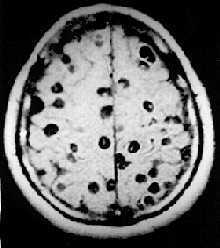
Cestodes (tapeworms) and digeneans (flukes) cause important diseases in humans and their livestock, and monogeneans can cause serious losses of stocks in fish farms.[31] Schistosomiasis, also known as bilharzia or snail fever, is the second-most devastating parasitic disease in tropical countries, behind malaria. The Carter Center estimated 200 million people in 74 countries are infected with the disease, and half the victims live in Africa. The condition has a low mortality rate, but often is a chronic illness that can damage internal organs. It can impair the growth and cognitive development of children, and increase the risk of bladder cancer in adults. The disease is caused by several flukes of the genus Schistosoma, which can bore through human skin. The people most at risk are those who use infected bodies of water for recreation or laundry.[18]
In 2000, an estimated 45 million people were infected with the beef tapeworm Taenia saginata and 3 million with the pork tapeworm Taenia solium.[31] Infection of the digestive system by adult tapeworms causes abdominal symptoms that are unpleasant but not disabling or life-threatening.[32][33] However, neurocysticercosis resulting from penetration of T. solium larvae into the central nervous system is the major cause of acquired epilepsy worldwide.[34] In 2000, about 39 million people were infected with trematodes (flukes) that naturally parasitize fish and crustaceans, but can pass to humans who eat raw or lightly cooked seafood. Infection of humans by the broad fish tapeworm Diphyllobothrium latum occasionally causes vitamin B12 deficiency and, in severe cases, megaloblastic anemia.[31]
The threat to humans in developed countries is rising as a result of social trends: the increase in organic farming, which uses manure and sewage sludge rather than artificial fertilizers, and spreads parasites both directly and via the droppings of seagulls which feed on manure and sludge; the increasing popularity of raw or lightly cooked foods; imports of meat, seafood and salad vegetables from high-risk areas; and, as an underlying cause, reduced awareness of parasites compared with other public health issues such as pollution. In less-developed countries, inadequate sanitation and the use of human feces (night soil) as fertilizer and to enrich fish farm ponds continues to spread parasitic platyhelminths, and poorly designed water-supply and irrigation projects have provided additional channels for their spread. People in these countries often cannot afford the cost of fuel required to cook food thoroughly enough to kill parasites. Controlling parasites that infect humans and livestock has become more difficult, as many species have become resistant to drugs that used to be effective, mainly for killing juveniles in meat.[31] While poorer countries still struggle with unintentional infection, cases have been reported of intentional infection in the US by dieters desperate for rapid weight-loss.[35]
Pests
There is concern about the proliferation in northwest Europe, including the British Isles, of the New Zealand planarian Arthurdendyus triangulatus and the Australian flatworm Australoplana sanguinea, both of which prey on earthworms.[36] A. triangulatus is thought to have reached Europe in containers of plants imported by botanical gardens.[37]
Benefits
In Hawaii, the planarian Endeavouria septemlineata has been used to control the imported giant African snail Achatina fulica, which was displacing native snails, and Platydemus manokwari, another planarian, has been used for the same purpose in Philippines, Indonesia, New Guinea and Guam. Although A. fulica has declined sharply in Hawaii, there are doubts about how much E. septemlineata contributed to this. However, P. manokwari is given credit for severely reducing, and in places exterminating, A. fulica – achieving much greater success than most biological pest control programs, which generally aim for a low, stable population of the pest species. The ability of planarians to take different kinds of prey and to resist starvation may account for their ability to decimate A. fulica. However, these abilities have raised concerns that planarians may themselves become a serious threat to native snails.[38] [39]
A study[40] in La Plata, Argentina shows the potential for planarians such as Girardia anceps, Mesostoma ehrenbergii, and Bothromesostoma evelinae to reduce populations of the mosquito species Aedes aegypti and Culex pipiens. The experiment showed that G. anceps in particular can prey on all instars of both mosquito species and maintain a steady predation rate over time. The ability for these flatworms to live in artificial containers showed the potential of placing these species in popular mosquito breeding sites, which would ideally reduce the amount of mosquito-borne diseases.
特点
分類
傳統分類
以下為按照傳統分類方法最新近的分類:
現時分類
根據分子親緣支序學,本門的物種都被重新分類過,與傳統分類的差異很大。現時本門物種被分為下列兩大支:
- 小鎖狀目 Catenulida
- 被杆體綱 Rhabditophora
參考文獻
- Dentzien-Dias, PC; Poinar, G Jr; de Figueiredo, AE; Pacheco, AC; Horn, BL; Schultz, CL. . PLOS ONE. 30 January 2013, 8 (1): e55007. PMC 3559381. PMID 23383033. doi:10.1371/journal.pone.0055007.
- Ehlers, U.; Sopott-Ehlers, B. . Hydrobiologia. June 1995, 305: 1. ISBN 9789401100458. doi:10.1007/BF00036354.
- Zhang, Zhi-Qiang. . Zootaxa. 2013-08-30, 3703 (1): 5 [2020-04-11]. doi:10.11646/zootaxa.3703.1.3. (原始内容存档于2019-04-24).
- Walker, J.C.; Anderson, D.T. . Anderson, D.T. (编). . Oxford University Press. 2001: 58–80. ISBN 978-0-19-551368-4.
- Hinde, R.T. . Anderson, D.T. (编). . Oxford University Press. 2001: 28–57. ISBN 978-0-19-551368-4.
- Barnes, R.S.K. . Blackwell Publishing. 1998: 194–195 [2008-12-21]. ISBN 978-0-632-04917-2.
- Ruppert, E.E.; Fox, R.S.; Barnes, R.D. 7. Brooks / Cole. 2004: 226–269. ISBN 978-0-03-025982-1. 已忽略未知参数
|name-list-style=(帮助); 已忽略未知参数|url-access=(帮助) - Klaus Rohde. . Encyclopaedia of Life Sciences. 2001. ISBN 0470016175. doi:10.1038/npg.els.0001585.
- Ruppert, E.E.; Fox, R.S.; Barnes, R.D. 7. Brooks / Cole. 2004: 196–224. ISBN 978-0-03-025982-1. 已忽略未知参数
|name-list-style=(帮助); 已忽略未知参数|url-access=(帮助) - Ehlers, U. . S Conway Morris; JD George; R Gibson; HM Platt (编). . Oxford: Clarendon Press. 1985: pp 143–158 (英语).
- Jondelius, U.; Ruiz-Trillo, I.; Baguñà, J.; Riutort, M. . Zoologica Scripta. April 2002, 31 (2): 201–215. doi:10.1046/j.1463-6409.2002.00090.x.
- Halanych, K.M. (PDF). Annual Review of Ecology, Evolution, and Systematics. 2004, 35: 229–256 [28 Oct 2010]. doi:10.1146/annurev.ecolsys.35.112202.130124. (原始内容存档 (PDF)于2017-06-11).
- Larsson, K.; Jondelius, U. . Organisms Diversity & Evolution. 20 December 2008, 8 (5): 378–387. doi:10.1016/j.ode.2008.09.002.
- Wallberg, A.; Curini-Galletti, M.; Ahmadzadeh, A. & Jondelius, U. . Zoologica Scripta. September 2007, 36 (5): 509–523. doi:10.1111/j.1463-6409.2007.00295.x.
- Westblad, E. . Arkiv för Zoologi. 1949, 1: 3–29.
- Bourlat SJ, Nielsen C, Lockyer AE, Littlewood DT, Telford MJ. . Nature. 21 August 2003, 424 (6951): 925–928. PMID 12931184. doi:10.1038/nature01851.
- Newman, Leslie. . PBS. [2008-12-21]. (原始内容存档于2013-11-14).
- The Carter Center. . [2008-07-17]. (原始内容存档于2008-07-20).
- Justine JL, Rahmouni C, Gey D, Schoelinck C, Hoberg EP. . PLOS ONE. 2013, 8 (11): e79155. PMC 3838368. PMID 24278118. doi:10.1371/journal.pone.0079155.
- Timothy, D.; Littlewood, J.; Telford, M.J. & Bray, R.A. . Cracraft, J. & Donoghue, M.J. (编). . Oxford University Press US. 2004: 209–223 [2008-12-23]. ISBN 0-19-517234-5.
- Boll, P. K.; Rossi, I.; Amaral, S. V.; Oliveira, S. M.; Müller, E. S.; Lemos, V. S.; Leal-Zanchet, A. M. . Neotropical Biology and Conservation. 2013, 8 (1): 41–52. doi:10.4013/nbc.2013.81.06.
- Egger, B.; Lapraz, F.; Tomiczek, B.; Müller, S.; Dessimoz, C.; Girstmair, J.; Škunca, N.; Rawlinson, K. A.; Cameron, C. B.; Beli, E.; Todaro, M. A.; Gammoudi, M.; Noreña, C.; Telford, M. I. . Current Biology. 18 May 2015, 25 (10): 1347–1353. PMC 4446793. PMID 25866392. doi:10.1016/j.cub.2015.03.034.
- De Baets, K., P. Dentzien-Dias, I. Upeniece, O. Verneau and P. C. J. Donoghue. . Kenneth De Baets and D. Timothy J Littlewood (编). 90. : 93–135. ISBN 978-0-12-804001-0. doi:10.1016/bs.apar.2015.06.002.
- Poinar, G. . Invertebrate Biology. 2003, 122 (4): 308–312. JSTOR 3227067. doi:10.1111/j.1744-7410.2003.tb00095.x.
- Carranza, S.; Baguñà, J. & Riutort, M. . Molecular Biology and Evolution. May 1, 1997, 14 (5): 485–497 [2008-12-23]. PMID 9159926. doi:10.1093/oxfordjournals.molbev.a025785. (原始内容存档于2009-02-07).
- Bourlat SJ, Juliusdottir T, Lowe CJ, Freeman R, Aronowicz J, Kirschner M, Lander ES, Thorndyke M, Nakano H, Kohn AB, Heyland A, Moroz LL, Copley RR, Telford MJ. . Nature. 2006, 444 (7115): 85–88. PMID 17051155. doi:10.1038/nature05241.
- Willems, W.R.; Wallberg, A.; Jondelius, U.; 等. (PDF). Zoologica Scripta. 2005, 35 (1): 1–17 [2008-12-23]. doi:10.1111/j.1463-6409.2005.00216.x. (原始内容 (PDF)存档于2011-10-06).
- Lockyer, A.E.; Olson, P.D. & Littlewood, D.T.J. . Biological Journal of the Linnean Society. 2003, 78 (2): 155–171. doi:10.1046/j.1095-8312.2003.00141.x.
- Ehlers, U. . Hydrobiologia. 1986, 132 (1): 1–12. doi:10.1007/BF00046222.
- Perkins, EM; Donnellan, SC; Bertozzi, T; Whittington, ID. . Int J Parasitol. 2010, 40 (11): 1237–45. doi:10.1016/j.ijpara.2010.02.017.
- Northrop-Clewes, C.A.; Shaw, C. (PDF). British Medical Bulletin. 2000, 56 (1): 193–208 [2008-12-24]. PMID 10885116. doi:10.1258/0007142001902897. (原始内容 (PDF)存档于2009-08-16).
- García, H.H.; Gonzalez, A.E.; Evans, C.A.W. & Gilman, R.H. . The Lancet. 2003, 362 (9383): 547–556. PMC 3103219. PMID 12932389. doi:10.1016/S0140-6736(03)14117-7.
- WHO Expert Committee. (PDF). Bulletin of the World Health Organization. 1987, 65 (5): 575–588 [2008-12-24]. PMC 2491073. PMID 3501340. (原始内容 (PDF)存档于2009-08-16).
- Commission on Tropical Diseases of the International League Against Epilepsy. . Epilepsia. 1994, 35 (1): 89–93. PMID 8112262. doi:10.1111/j.1528-1157.1994.tb02916.x.
- . Today (U.S. TV program). 2013-08-16 [2017-11-06]. (原始内容存档于2017-11-07).
- Flatworm information sheet – Isle of Man Government 的存檔,存档日期2013-05-01.
- Boag, B.; Yeates, G.W. . Ecological Applications. 2001, 11 (5): 1276–1286. ISSN 1051-0761. doi:10.1890/1051-0761(2001)011[1276:TPIOTN]2.0.CO;2.
- Barker, G.M. . . CABI Publishing. 2004: 261–263. ISBN 0-85199-319-2.
- Justine, Jean-Lou; Winsor, Leigh; Gey, Delphine; Gros, Pierre; Thévenot, Jessica. . PeerJ. 2014, 2: e297. PMC 3961122. PMID 24688873. doi:10.7717/peerj.297.

- . Biological Control: 270–276. doi:10.1016/j.biocontrol.2008.12.010.
延伸閱讀
- Campbell, Neil A., Biology: Fourth Edition (Benjamin/Cummings Publishing, New York; 1996; page 599) ISBN 0-8053-1957-3
- Crawley, John L., and Kent M. Van De Graff. (editors); A Photographic Atlas for the Zoology Laboratory: Fourth Edition) (Morton Publishing Company; Colorado; 2002) ISBN 0-89582-613-5
- The Columbia Electronic Encyclopedia, 6th ed. (Columbia University Press; 2004) [Retrieved 8 February 2005] 页面存档备份,存于
- Evers, Christine A., Lisa Starr. Biology: Concepts and Applications. 6th ed. United States:Thomson, 2006. ISBN 0-534-46224-3.
- Saló, E; Pineda, D; Marsal, M; Gonzalez, J; Gremigni, V; Batistoni, R. . Gene. 2002, 287 (1–2): 67–74. PMID 11992724. doi:10.1016/S0378-1119(01)00863-0.
